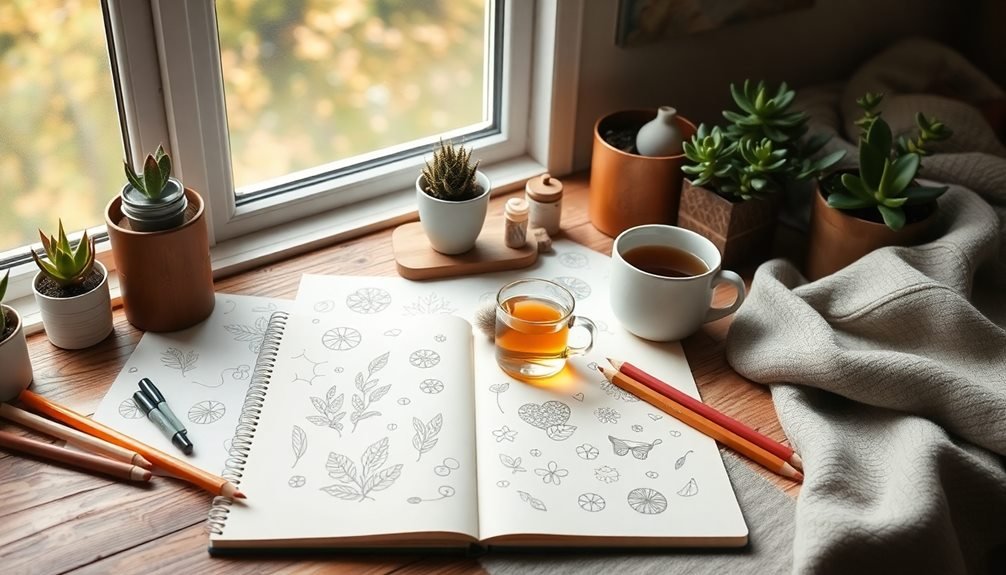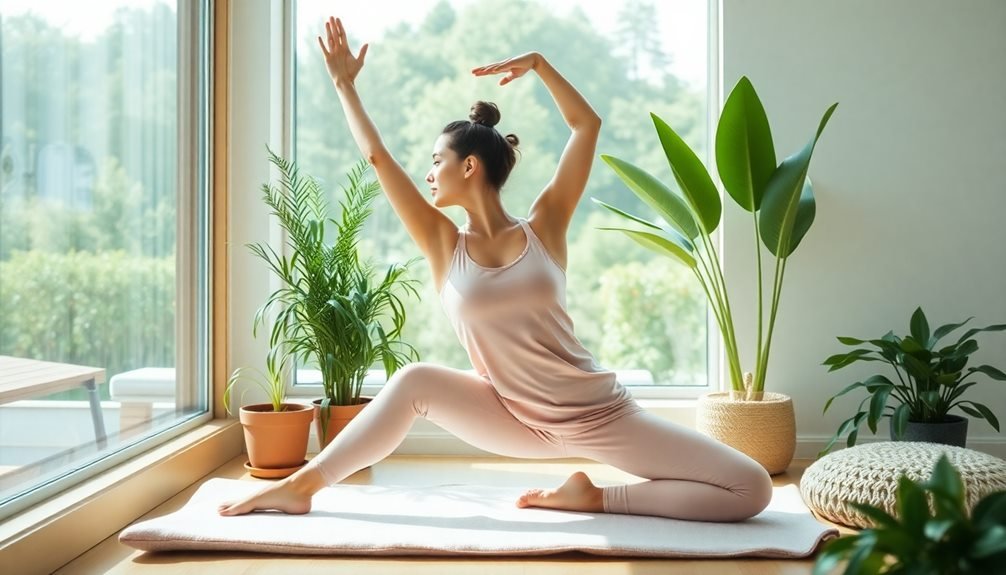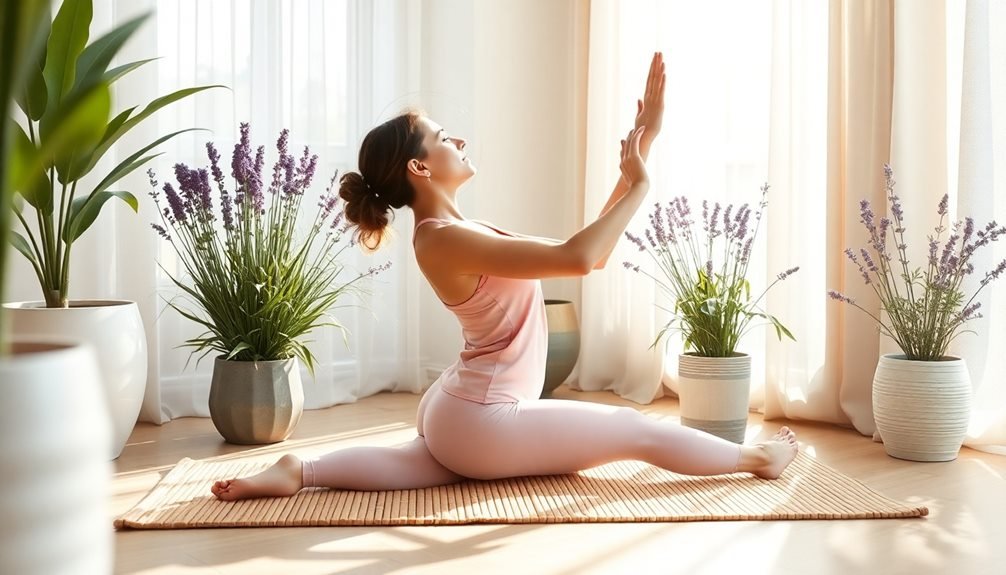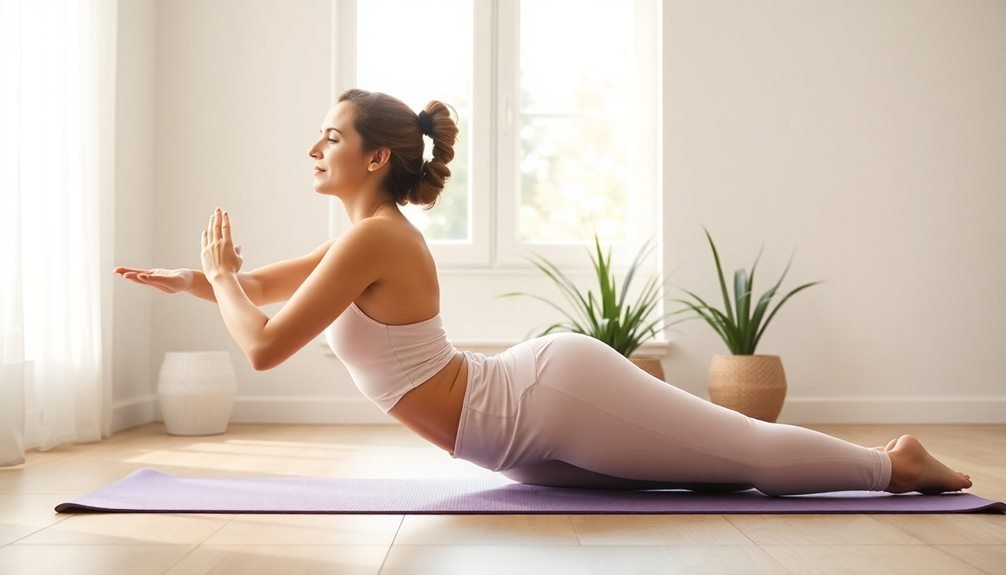Soothing sketching activities can help calm your anxious mind through mindful, repetitive motions. You'll find peace in nature pattern doodling, where you'll replicate organic elements like ferns and flower petals. Try mindful line drawing with simple parallel lines or gentle waves, focusing on your breath and pen pressure. Breathing rhythm sketches sync your inhales and exhales with upward and downward strokes, while single object focus practice encourages deep observation. Gentle color meditation and zentangle patterns offer additional paths to artistic tranquility. These six calming techniques open doors to both creative expression and emotional well-being.
Nature Pattern Doodling

Every leaf, petal, and branch in nature follows mesmerizing patterns that you can easily replicate in your sketchbook. Start by selecting simple natural elements like ferns, pine needles, or flower petals, then draw them repeatedly across your page in overlapping sequences. You'll find that this repetitive process naturally calms your mind while creating beautiful organic patterns.
To begin nature pattern doodling, divide your page into small sections and fill each with a different natural motif. Draw spiraling shells, honeycomb hexagons, or rippling water circles. You don't need perfect symmetry – nature itself isn't perfectly symmetrical. Let your hand flow freely as you sketch these elements, focusing on the rhythmic motion rather than achieving precision.
Try experimenting with various natural textures: bark patterns, leaf veins, or cloud formations. Use different line weights to add depth, and incorporate dotwork to create subtle shading.
When anxiety rises, concentrate on drawing one simple pattern repeatedly. The predictable, flowing movements of your pen combined with nature-inspired designs will help ground your thoughts and reduce stress through mindful observation and recreation.
Mindful Line Drawing
Simple lines can bring about profound calmness when drawn with intention and focus. Mindful line drawing invites you to slow down and concentrate on creating basic shapes and patterns while remaining present in the moment.
You'll find that repeating gentle strokes across your paper creates a meditative rhythm that helps quiet anxious thoughts.
Start by selecting a fine-point pen or soft pencil that glides smoothly across your paper. As you draw, focus on your breathing and the sensation of your tool making contact with the surface. You don't need complex patterns—simple horizontal, vertical, or curved lines work perfectly.
- Draw parallel lines slowly across your page, maintaining consistent spacing and pressure
- Create gentle waves or ripples that flow from one edge to another
- Form concentric circles, starting from the center and working outward
- Practice continuous line drawing without lifting your pen from the paper
Breathing Rhythm Sketches

Synchronizing your breath with your sketching creates a powerful calming effect that can instantly reduce anxiety. By matching your pencil strokes to your inhales and exhales, you'll develop a natural rhythm that helps quiet racing thoughts and steady your hand.
Start by drawing simple curved lines, moving your pencil upward as you breathe in and downward as you breathe out.
Try creating wave patterns that reflect your breathing pattern. Draw gentle, rolling waves for slow, deep breaths, or shorter, choppier waves when your breathing is quick. You can also experiment with circular motions, drawing the top half of a circle during inhalation and completing the bottom half while exhaling.
As you become more comfortable, incorporate different pressures – lighter strokes for inhales, firmer ones for exhales.
Don't worry about perfection or creating recognizable shapes. Instead, focus on how your breath guides your hand across the paper. If your mind wanders, gently return your attention to the connection between your breathing and the marks you're making.
This exercise works particularly well with soft graphite pencils or smooth-flowing pens.
Single Object Focus Practice
Building on the mindful practice of breath-synchronized sketching, focusing on a single object can further deepen your artistic meditation. Choose one simple item from your immediate environment – perhaps a coffee mug, a houseplant, or a desk lamp. You'll spend 15-20 minutes studying and sketching only this object, letting all other distractions fade away.
When you're working with your chosen object, you'll want to observe its details with heightened awareness. Notice how light interacts with its surface, the subtle variations in texture, and the unique characteristics that make it distinct. Don't worry about creating a perfect representation; instead, focus on the calming process of observation and mark-making.
- Start with simple outlines and gradually add more intricate details as you become more absorbed in the practice.
- Rotate the object periodically to discover new angles and perspectives.
- Take breaks to close your eyes and visualize the object before continuing to draw.
- Experiment with different drawing tools to find what feels most soothing – soft pencils, felt tips, or brush pens.
This concentrated attention helps quiet racing thoughts while improving your observational skills and artistic technique.
Gentle Color Meditation

After mastering single object focus, you'll find peace in exploring color through mindful meditation. Choose a color that resonates with your current emotional state and gather various shades of that hue in your preferred medium – watercolors, colored pencils, or markers. Create small, repetitive patterns while focusing on your breathing and the way each shade flows into the next.
| Emotion | Color Suggestions |
|---|---|
| Calm | Blues, Soft Greens |
| Joy | Yellows, Orange |
| Peace | Lavender, Mint |
| Balance | Earth tones, Teal |
Start with simple geometric shapes – circles, squares, or triangles – and fill them with your chosen colors. Don't worry about perfection; instead, concentrate on how each shade makes you feel. Layer your colors gradually, building depth while maintaining a gentle touch. This practice helps reduce anxiety by combining color therapy with meditative movement.
As you work, notice how different color combinations affect your mood. You might find certain pairings particularly soothing or energizing. Document these discoveries in a color journal to help identify which palettes best support your emotional well-being during future sketching sessions.
Zentangle Stress Relief
Zentangle patterns offer a structured yet liberating approach to mindful sketching. This meditative art form breaks down complex designs into simple, repetitive strokes that you'll find both calming and achievable. As you create these patterns, you'll notice your anxiety melting away while your focus sharpens on each deliberate line.
You don't need artistic expertise to begin zentangling. Start with basic patterns like straight lines, curves, and dots, then gradually build complexity as your confidence grows. The beauty of zentangle lies in its forgiving nature – there's no wrong way to draw these patterns, and what might seem like mistakes often become unique design elements.
- Use a fine-tipped pen to draw small, repeating patterns within a 3.5-inch square tile
- Focus on one stroke at a time, letting your mind quiet as you work
- Experiment with different patterns like circles, waves, and geometric shapes
- Avoid planning the outcome; let the design evolve naturally
When you're feeling overwhelmed, zentangle provides a perfect escape into creative flow. The rhythmic nature of drawing these patterns helps regulate breathing and reduces stress hormones while producing a satisfying artistic result.
Frequently Asked Questions
Can Sketching Activities Help Reduce Anxiety Even for People With Trembling Hands?
Yes, you can still benefit from sketching even with trembling hands. Try using broader strokes, looser styles, or digital tools with stabilization features. The focus is on self-expression and relaxation, not perfection.
What Art Supplies Are Best for Anxiety-Reducing Sketching While Traveling?
Pack a small sketchbook, mechanical pencils, felt-tip pens, and water-soluble brush pens. They're compact, won't leak, and don't require water. You'll find these supplies perfect for anxiety-reducing sketches on-the-go.
How Long Should Each Soothing Sketching Session Last for Maximum Benefit?
You'll find the most benefit in 15-30 minute sketching sessions, but don't force it. Listen to your body – if you're feeling calm after 10 minutes or need an hour, that's perfectly fine.
Are Digital Sketching Apps as Effective for Anxiety Relief as Traditional Methods?
You'll find both digital and traditional sketching can ease anxiety, but traditional methods often provide better sensory feedback. The tactile feel of paper and pencils may help you feel more grounded and connected.
Should Anxious Artists Avoid Caffeine Before Engaging in Calming Sketching Activities?
You'll want to limit caffeine before sketching to reduce jitters and anxiety. It's best to avoid coffee or energy drinks at least 2-3 hours before your art session for a more relaxed experience.
In Summary
You'll find these sketching activities provide a calming sanctuary when anxiety feels overwhelming. Whether you're creating nature-inspired patterns, following your breath with simple lines, or losing yourself in zentangle designs, each technique offers a mindful escape. Remember, there's no pressure for perfection – these exercises aren't about the final product but about finding peace in the creative process. Let your pen guide you toward tranquility.





Leave a Reply